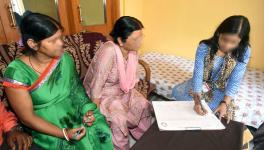Not AIMIM or Congress, Answers to Bihar Verdict 2020 Lie Elsewhere
Representational use only. Image Source BS
“This election was won (and lost) during the campaign. The BJP-led alliance led at the beginning and trailed at the end. It was undone by its own mistakes.” This post-poll observation by James Manor on the 2015 Bihar Assembly election has come true again—except this time, the winner and runner-up changed places.
Before campaigning began for the 2020 Assembly poll, many believed the Bihar Assembly election would be a cakewalk for the NDA. Yet, for close watchers of Bihar politics, the schedule of the three-phase election was enough to raise apprehensions of polarisation. This turned out to be true in retrospect—as the number of Muslim voters rose through the three phases, to reach the highest proportion in the third and final phase, the BJP stepped up its communal rhetoric.
Second, Tejashwi’s leadership and crowd-pulling ability improved immensely during this campaign. He enthused Mahagathbandhan (MGB) supporters, though this created a tendency for counter-consolidation of non-Yadav OBCs, who are more comfortable with Chief Minister Nitish Kumar’s JD-U. Both coalitions realised early on that the MGB had an edge over the NDA. While the latter recalibrated its strategy and resorted to polarising tactics (JP Nadda talked about bhoomi pujan at Ayodhya, NPR-NRC-CAA etc), the RJD perhaps was overconfident of the MGB getting 160-plus seats.
Tejashwi’s core voters ditched him in the second and third phases, particularly in Mithila and Tirhut regions in favour of Yadav candidates fielded by the NDA and some independents. For instance, in Paroo, Muzaffarpur, Muslim voters were misled into believing they will not be able to defeat the BJP without Yadav voters (together, Muslims and Yadavs comprise around a third of Bihar electorates). The RJD handed this seat to the Congress party, which fielded a local Bhumihar with a clean image. Bhumihars are the third-biggest community in Paroo and support the BJP. It was hoped the Congress would dent this bastion and, along with Muslims and Yadavs, get enough votes to defeat the incumbent BJP candidate. Yet, a RJD rebel and Yadav candidate, who had consistently lost to BJP’s Rajput candidates in previous elections, got all the MGB votes, facilitating BJP’s fourth consecutive victory.
The Yadav tendency to migrate from the MGB intensified if a candidate was Muslim. Non-Yadavs fielded by the MGB on seats won by Yadavs in the past also did not get Yadav votes, such as CPIML’s Aftab Alam in Aurai, Muzaffarpur. Arguably, this flight of voters has more to do with Yadavisation and less with saffronisation. RJD even lost some seats in Yadav-dominated Madhepura, where Muslim voters hardly count.
Besides, these fleeing voters did not directly transfer allegiance to BJP. As in Paroo, in Gopalganj, Yadav votes went to BSP’s Sadhu Yadav, brother-in-law of former CM Lalu Yadav. Asif Ghafoor, grandson of former CM Abdul Ghafoor, was the Congress candidate in Gopalganj, Lalu’s home turf. Sadhu Yadav got more than 41,000 votes whereas Asif got just around 36,500—and the BJP won with a margin of around 36,000.
This proposition is fortified by the Left’s victory in 16 of 29 seats communist parties contested on—the Left could transfer votes to MGB, while RJD and allies could not reciprocate sufficiently. The Aurai seat is a representative example: Here, Muslims are estimated at around 23% and Aftab got only around that many votes. In Dhaka, East Champaran, RJD’s Faisal Rahman was seeking re-election and lost to BJP’s Yadav candidate. Seats in Mithilanchal present an even more glaring example: Many Muslim and Yadav workers of RJD allege that the RJD strongmen in Mithilanchal, Lalit Yadav and Bhola Yadav, supposedly a mentor of Tejashwi, worked against Muslim MGB candidates.
The estimated proportion of Muslims compared with total MGB votes secured in a few constituencies in which it fielded Muslim candidates is as below:
-
Keoti, Darbhanga has 42% Muslim votes, and senior RJD leader Abdul Bari Siddiqui got just 43.61% of votes.
-
Gaura Bauram has 32% Muslim votes, while RJD’s Afzal Khan got 36% votes.
-
Jalley has 34% Muslims and Congress’ Mashkoor Usmani got 38% votes.
-
Bisfi has 37% Muslims and RJD’s Faiyaz Alam got 42% votes.
-
Aurai has around 23% Muslims and CPIML’s Aftab Alam got just as many.
-
Dhaka (East Champaran) has 43% Muslims and RJD’s Faisal Rahman got just as many.
-
Supaul (Kosi) has 28% Muslims and Congress’ Minnatullah Rahmani got just 34% votes.
-
Sursand (Sitamarhi) has 24% Muslims and RJD’s Syed Abu Dojana got just 34% votes.
-
Forbesganj (Kosi belt) has 37% Muslims and Congress’ Zakir Husain got just around 40% votes.
-
Pranpur has 38% Muslims and the Congress’ Tauqir Alam got just 38% votes.
-
In Narpatganj (Araria), BJP’s JP Yadav got around 98,000 votes, while RJD got around 70,000.
The RJD, therefore, should not blame the Congress too much, nor should the Congress blame the AIMIM and Asaduddin Owaisi beyond a point. Lalu Yadav was reportedly “furious” and “seething with rage” at the Congress, but this is not too fair considering the RJD’s cadres preferred Yadav candidates outside the MGB. This is also a result of RJD’s refusal to reach out to non-Yadav OBCs and Dalits in a substantive way. Consider Ramai Ram, a nine-time RJD MLA, who could have been projected as a non-Yadav deputy CM, as could another young leader have been. Ram lost from Bochahan in Muzaffarpur and his daughter, Geeta, BSP nominee from Sakra, secured 2,000 votes. Congress party’s Umesh Ram lost this seat by a narrow margin of 1,700 votes.
Vote-transfers are a sine qua non for coalition politics. For instance, the LJP invariably succeeds in transferring Pasi/Paswan votes to allies.
NDA gains beyond Seemanchal
The RJD and Congress must set their house in order before training their guns against each other or Owaisi. After all, of the five seats AIMIM has won, it has snatched more from the NDA and less from the MGB. Nor has it helped NDA win (by denting the MGB support base) on the remaining 15 seats it contested. Therefore, opinion-makers must not load Muslims with guilt over the losses of the MGB. The AIMIM even lost the Kishanganj seat which it had won in a by-election a year ago.
The many cliffhangers in the recent contest signify that despite apparent anti-incumbency, not enough voters desired regime change, particularly non-Yadav OBCs and many Dalit communities, who counter-consolidated against apparent Yadav assertion at Tejashwi’s rallies. It was amply clear since the 2019 Lok Sabha election that Tejashwi needed to reach out to non-Yadav OBCs and Dalits by projecting leaders from these communities. Instead, Tejashwi attempted to monopolise power and Yadavisation came at the expense of other subaltern groups. This is a critical reason why RJD was unable to form government this time. The NDA camp understands this far better and now plans to place backward leaders in prime posts.
In Bihar’s deeply-fractious polity, various social groups and identities struggle to share power. In addition, regular doses of communal polarisation have guided an upper caste attempt to return to power after a three-decade gap. Their desperation for power has been apparent ever since 2017, when Yogi Adityanath, a Rajput, became chief minister in Uttar Pradesh. Rajput outfits such as Karni Sena and Adityanath’s Hindu Yuva Vahini have been spreading their organisation and cadres in Rajput settlements in parts of Bihar contiguous with Gorakhpur, the base of Adityanath’s operations. The Sushant Singh Rajput issue was imported into Bihar from the Mumbai film world, fanning an unusual spectacle—aided by large sections of the media—to deflect from the catalogue of grievances against the incumbent regime by harping on “Bihari pride”.
Migrant workers and unemployment
This election was also a verdict on migrant worker’s issues. Their crisis was cunningly diverted from by communalising the pandemic in the early stages, to which also a large section of the media contributed. While workers suddenly confronted a lockdown, the Opposition faltered in cornering the incumbent regime’s missteps.
That said, RJD’s Tejashwi Yadav immensely improved his leadership skills during this election, by setting a concrete agenda of employment and benefits to youth and farmers, which pulled massive crowds. Still Bihar-watchers missed the fear of Yadav dominance that persists among non-Yadav Shudras and Dalits. Given that 47% (35 of 75) of RJD MLAs are Yadav, other OBCs identify less with RJD and more with the JDU and BJP. On many seats, Muslim and Yadav voters comprise 40% or more of voters, but this has made RJD lax on accommodation, especially in the top rungs. Upendra Kushwaha, Mukesh Sahni and Jitan Ram Manjhi were not given substantive enough offers, though given the prevailing saffronisation, it is moot how effectively these leaders could have transferred their core voters to the MGB as compared to the NDA.
Narratives were cleverly shaped to direct anti-incumbency against Nitish and not its ally, the BJP. LJP’s Chirag Paswan became a willing pawn, readily ending up with a single seat. Anti-NDA votes were nullified to an extent and JD-U’s tally reduced enough to make BJP the biggest constituent of the NDA. In this scheme, the RJD inevitably rose at the cost of the JD-U as it got the benefit of a divided NDA house—LJP pitted against JD-U. It also gained from Muslim consolidation behind MGB, barring Seemanchal. Given the ire against CAA-NPR-NRC, the JD-U (being a BJP ally) was almost completely deserted by Muslims. All 11 Muslim JD-U candidates who sought re-election have lost.
The outspoken opposition of AIMIM’s Owaisi to the BJP’s religion-led citizenship drive earned him five seats in Seemanchal for the first time. Though this victory barely affected the MGB in terms of seat shares, the Congress and RJD need some soul-searching on why AIMIM succeeded at all. For the last five years, the RJD and Congress remained complacent on Muslim grievances. The RJD invisibilised Muslims on its pre- and post-election platforms. On 12 November, Tejashwi’s mercurial brother Tej Pratap sat on-stage but no Muslim leader. The party’s manifesto was released with Lovely Anand (whose husband is a gangster) and Jagdanand Singh, both Rajputs, on-stage, but no Muslim agaon. When seat-sharing was announced, Muslim leaders were again conspicuously absent. Young Muslims raged on social media about this, but nothing was done.
As identity politics takes centre-stage, Bihar watchers are wondering whether the BJP would pursue communally-divisive majoritarian consolidation to become a hegemonic political force in Bihar. A resurgent Left will be expected to play a more challenging role as economic inequality grows due to rural distress, privatisation, de-industrialisation and massive youth unemployment. Since 2013, Nitish has tried to control communalisation drives, but his JD-U is no longer a numerically stronger ally. Will communal polarisation now thrive in Bihar or governance? This is the biggest challenge before the Opposition in Bihar.
The author teaches modern and contemporary Indian history at Aligarh Muslim University. The views are personal.
Get the latest reports & analysis with people's perspective on Protests, movements & deep analytical videos, discussions of the current affairs in your Telegram app. Subscribe to NewsClick's Telegram channel & get Real-Time updates on stories, as they get published on our website.























